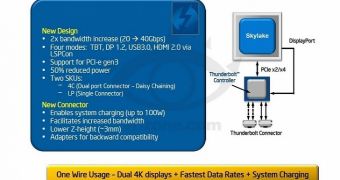Technological advancements are something that engineers and designers do their best to make backwards-compatible, but sometimes things aren't so clearly cut, and the case of Thunderbolt technology is an example of that.
Thunderbolt is that interface that Intel invented as a sort of faster alternative to Universal Serial Bus (USB), but which few tech/PC companies actually use, besides Apple.
Thunderbolt has proven quite adept at video and other media streaming, thanks to its inclusion of DisplayPort specifications.
However, motherboard and personal computer makers have proven less than welcoming to the idea of another connectivity interface.
Intel is persevering though, having already gotten near the point where it's ready to reveal the third generation of Thunderbolt.
That's what the folks at VRZone say at least. Intel hasn't actually said anything officially on the matter, though there is some evidence to support the veracity of the leak.
After all, Thunderbolt is already at the second generation, capable of 20 Gbps throughput, or at least that's the theoretical top limit.
As we've seen with pretty much every other connectivity standard out there though, just because it's possible to reach a performance, it doesn't mean it's actually done.
USB 3.0 products don't actually attain 5 Gbps, and the full USB 2.0 480 Mbps transfer rate was only used in full once USB 3.0 came out.
Anyway, the new Thunderbolt 3.0 technology promises up to 40 Gbps speed, which is twice the current maximum. It seems that the progression is from double to double here, unlike on USB where it was a tenfold rise from USB 2.0 to 3.0.
Granted, USB 3.1 promises 10 Gbps, which is twice that of USB 3.0. But that's the thing, this is USB 3.1, not USB 4.0. Who knows how fast that standard will run.
But we digress, and we haven't mentioned the one, big problem with Thunderbolt 3.0 yet: the new connector, which implies a total lack of backwards compatibility.
Ironically, though, it might actually be a blessing that Thunderbolt never caught on with anyone but Apple. It means that there isn't anyone who will actually mourn the previous port. And Apple already has its Lightning anyway, which shows that it doesn't really care if it has to switch ports regardless. Not that it's been confirmed that Apple will adopt TB 3.0, because it hasn't been.
Thunderbolt 3.0 is powered by the Apline Ridge controller and hasn't been given an ETA yet (estimated time of arrival).

 14 DAY TRIAL //
14 DAY TRIAL //